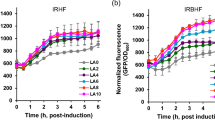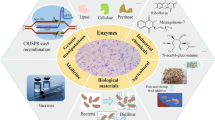Abstract
Objectives
To improve the production and molecular mass of the glycosaminoglycan hyaluronan (HA) in Bacillus subtilis by engineering hyaluronan synthase (HAS) from Streptococcus zooepidemicus.
Results
By mutating regions within HAS intracellular domains, five positive variants exhibiting higher HA production (from 1.22 to 2.24 g l−1) and molecular mass values (from 1.20 to 1.36 × 106 Da) were constructed and characterized. Overexpression of the V5 variant and the genes tuaD and glmU increased HA production and molecular mass to 2.8 g l−1 and 2.4 × 106 Da, respectively.
Conclusions
This study provides a novel strategy for improving HA production and its molecular mass.




Similar content being viewed by others
References
Badle SS, Jayaraman G, Ramachandran KB (2014) Ratio of intracellular precursors concentration and their flux influences hyaluronic acid molecular weight in Streptococcus zooepidemicus and recombinant Lactococcus lactis. Bioresour Technol 163:222–227
Chen YH, Wang Q (2009) Establishment of CTAB turbidimetric method to determine hyaluronic acid content in fermentation broth. Carbohydr Polym 78:178–181
Chen WY, Marcellin E, Hung J, Nielsen LK (2009) Hyaluronan molecular weight is controlled by UDP-N-acetylglucosamine concentration in Streptococcus zooepidemicus. J Biol Chem 284:18007–18014
Cheng F, Gong Q, Yu H, Stephanopoulos G (2015) High-titer biosynthesis of hyaluronic acid by recombinant Corynebacterium glutamicum. Biotechnol J 11:574–584
Gibson DG, Young L, Chuang RY, Venter JC, Hutchison CA, Smith HO (2009) Enzymatic assembly of DNA molecules up to several hundred kilobases. Nat Methods 6:343–345
Heldermon C, DeAngelis PL, Weigel PH (2001) Topological organization of the hyaluronan synthase from Streptococcus pyogenes. J Biol Chem 276:2037–2046
Jagannath S, Ramachandran KB (2010) Influence of competing metabolic processes on the molecular weight of hyaluronic acid synthesized by Streptococcus zooepidemicus. Biochem Eng J 48:148–158
Jin P, Kang Z, Yuan P, Du G, Chen J (2016a) Production of specific-molecular-weight hyaluronan by metabolically engineered Bacillus subtilis 168. Metab Eng 35:21–30
Jin P, Kang Z, Zhang J, Zhang L, Du G, Chen J (2016b) Combinatorial evolution of enzymes and synthetic pathways using one-step PCR. ACS Synth Biol 5:259–268
Jin P, Zhang L, Yuan P, Kang Z, Du G, Chen J (2016c) Efficient biosynthesis of polysaccharides chondroitin and heparosan by metabolically engineered Bacillus subtilis. Carbohydr Polym 140:424–432
Kumari K, Weigel PH (2005) Identification of a membrane-localized cysteine cluster near the substrate-binding sites of the Streptococcus equisimilis hyaluronan synthase. Glycobiology 15:529–539
Kumari K, Baggenstoss BA, Parker AL, Weigel PH (2006) Mutation of two intramembrane polar residues conserved within the hyaluronan synthase family alters hyaluronan product size. J Biol Chem 281:11755–11760
Marcellin E, Steen JA, Nielsen LK (2014) Insight into hyaluronic acid molecular weight control. Appl Microbiol Biotechnol 98:6947–6956
Prasad SB, Jayaraman G, Ramachandran KB (2010) Hyaluronic acid production is enhanced by the additional co-expression of UDP-glucose pyrophosphorylase in Lactococcus lactis. Appl Microbiol Biotechnol 86:273–283
Pummill PE, DeAngelis PL (2003) Alteration of polysaccharide size distribution of a vertebrate hyaluronan synthase by mutation. J Biol Chem 278:19808–19814
Weigel PH, DeAngelis PL (2007) Hyaluronan synthases: a decade-plus of novel glycosyltransferases. J Biol Chem 282:36777–36781
Widner B, Behr R, Von Dollen S, Tang M, Heu T, Sloma A, Sternberg D, Deangelis PL, Weigel PH, Brown S (2005) Hyaluronic acid production in Bacillus subtilis. Appl Environ Microbiol 71:3747–3752
Yu H, Stephanopoulos G (2008) Metabolic engineering of Escherichia coli for biosynthesis of hyaluronic acid. Metab Eng 10:24–32
Acknowledgments
This work was financially supported by a grant from the Key Technologies R & D Program of Jiangsu Province, China (BE2014607), the Program for Changjiang Scholars and Innovative Research Team in University (No. IRT_15R26) and the 111 Project.
Supporting information
Supplementary Table 1—Plasmids and primers used.
Author information
Authors and Affiliations
Corresponding author
Electronic supplementary material
Below is the link to the electronic supplementary material.
Rights and permissions
About this article
Cite this article
Zhang, L., Huang, H., Wang, H. et al. Rapid evolution of hyaluronan synthase to improve hyaluronan production and molecular mass in Bacillus subtilis . Biotechnol Lett 38, 2103–2108 (2016). https://doi.org/10.1007/s10529-016-2193-1
Received:
Accepted:
Published:
Issue Date:
DOI: https://doi.org/10.1007/s10529-016-2193-1




